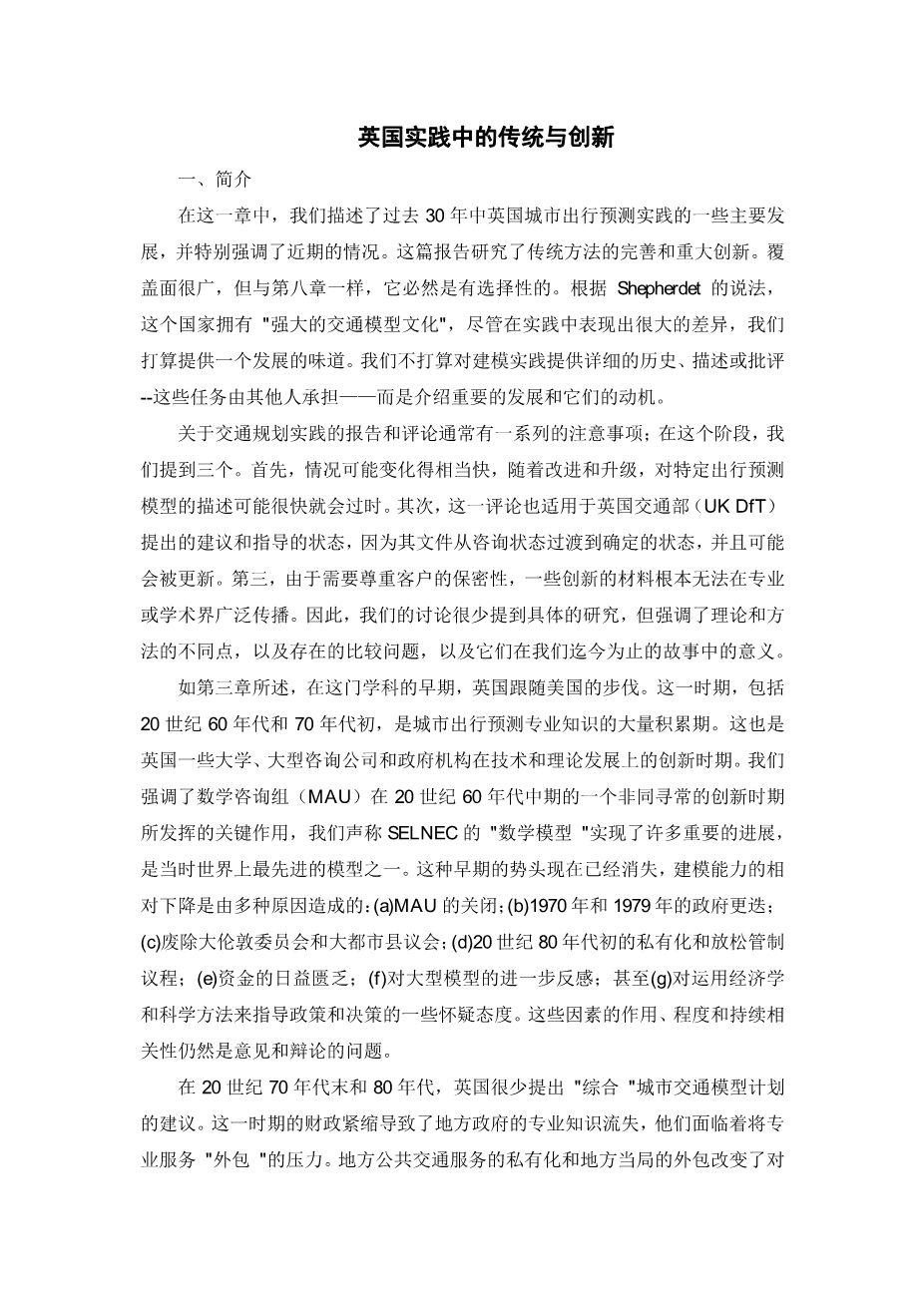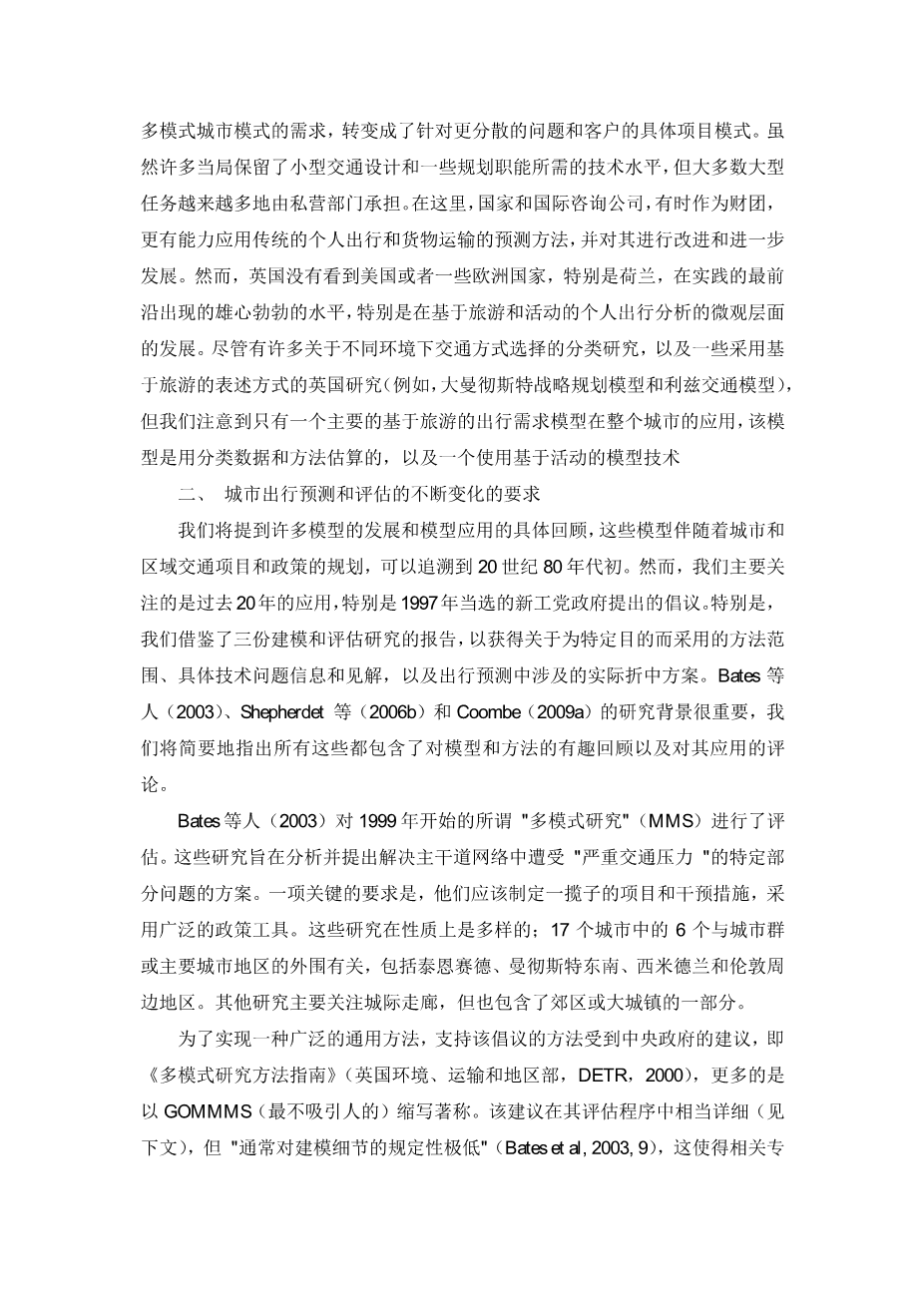英国实践中的传统与创新外文翻译资料
2023-04-08 22:54:05
Tradition and innovation in UK practice
INTRODUCTION
In this chapter we describe some of the major developments in urban travel forecasting practice in the UK over the past 30 years, with particular emphasis on recent times. This review examines the refinement of traditional methods as well as significant innovations. The coverage is wide- ranging, but as in Chapter 8 it is necessarily selective. We intend to give a flavor of developments in a country with, according to Shepherdet al (2006b, 313), lsquo;a strong culture of transport modelingrsquo;, albeit one exhibiting wide variations in practice. We do not intend to offer a detailed history, description or critique of modeling practice – tasks undertaken by others (as we discuss below in this section) but to introduce significant developments and the motivation for them.
Reports and reviews on transportation planning practice are usually subject to a range of caveats; we mention three at this stage. Firstly, circumstances can change fairly rapidly, and descriptions of particular travel forecasting models can soon become dated as refinements and upgrades are made. Secondly, this comment also applies to the status of advice and guidance emanating from the UK Department for Transport (UK DfT) as its documentation passes from consultative through to definitive status, and is subject to updating. Thirdly, because of the need to respect client confidentiality, some innovative material simply does not reach wider circulation among professional or academic audiences. Our discussion, therefore, mentions few specific studies, but emphasizes distinct points of theory and method, and comparative issues, where these exist, and their significance in our story so far.
As noted in Chapter 3, in the early days of the discipline, the UK followed where the US led. That period, which included the 1960s and early 1970s, was one of considerable build- up of expertise in urban travel forecasting. It was also a time of innovation in technical and theoretical development in some UK universities, the larger consultancies and government agencies. We emphasized the key role that the Mathematical Advisory Unit (MAU) played in an extraordinary period of innovation in the mid- 1960s, and we claimed that the SELNEC lsquo;mathematical modelrsquo;, which implemented numerous important advances, was one of the most sophisticated in the world at that time. That early momentum foundered, and a relative decline of modeling capability set in for a variety of reasons: (a) closure of the MAU; (b) change of governments in 1970 and 1979; (c) abolition of the Greater London Council and metropolitan county councils; (d) the privatization and deregulation agenda of the early 1980s; (e) increasing scarcity of funding; (f) a further wave of antipathy towards large- scale models; and even (g) some skepticism towards the deployment of economics and the scientific method to guide policy and decision making. The role, extent and continued relevance of such factors are still matters of opinion and debate.
In the late 1970s and 1980s, lsquo;comprehensiversquo; urban transportation modeling initiatives in the UK were infrequently requested. The financial stringencies of this period resulted in the dissipation of expertise from local authorities, which were under pressure to lsquo;out- sourcersquo; specialist services. 1 Privatization of local public transport services and local authority out- sourcing changed the need for multi- modal urban models into more project- specific models for a more dispersed set of problems and clients. While many authorities retained the level of technical skills required for minor transportation design and some planning functions, most of the larger tasks were increasingly undertaken by the private sector. Here national and international consultancies, sometimes acting as consortia, were more than able to apply traditional forecasting methods for personal travel and goods movement, and undertake their refinement and further development. The UK would not, however, witness the level of ambition that occurred at the cutting edge of practice in the US, or in some European countries, notably the Netherlands, particularly in regard to developments at the micro- level of tour- based and activity- based analyses of personal travel. Although there were many disaggregate studies of modal choice in various contexts, and a number of UK studies which adopted tour- based representations (e.g., the Greater Manchester Strategy Planning Model and the Leeds Transport Model), we note only one major conurbation-wide application of a tour- based travel demand model estimated with disaggregate data and methods and one using activity- based modeling techniques .
EVOLVING REQUIREMENTS FOR URBAN TRAVEL FORECASTING AND APPRAISAL
We shall refer to many model developments and specific reviews of model applications that accompanied the planning of urban and regional transportation projects and policies dating back to the early 1980s. Our main focus, however, is on applications during the past two decades, especially those resulting from the initiatives of the New Labour Government elected in 1997. In particular, we draw on three reports of modeling and appraisal studies in order to derive information and insights on the range of methods adopted for particular purposes, as well as specific technical issues, and the practical compromises involved in travel forecasting. The contexts of studies by Bates et al (2003), Shepherdet al (2006b) and Coombe (2009a) are important and are noted briefly. All contain interesting reviews of models and methods and comments on their application.
Bates et al (2003) was an assessment of the conduct of the so- calledlsquo;multi- modal studiesrsquo; (MMS) initiated in 1999. These studies were meant to analyses and propose solutions for addressing problems on particular parts of the trunk road network suffering from lsquo;severe transportation s
剩余内容已隐藏,支付完成后下载完整资料


英语译文共 7 页,剩余内容已隐藏,支付完成后下载完整资料
资料编号:[590313],资料为PDF文档或Word文档,PDF文档可免费转换为Word




